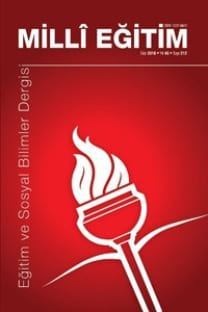ÖĞRETMEN ADAYLARININ COVID-19 PANDEMİSİ SÜRECİNDE UZAKTAN EĞİTİM UYGULAMALARINA İLİŞKİN GÖRÜŞLERİ
öğretmen, covid-19, pandemi, uzaktan eğitim, üniversite, sınıf eğitimi, matematik eğitimi
THE OPINIONS OF THE TEACHER CANDIDATES ON DISTANCE LEARNING PRACTICES IN THE COVID-19 PANDEMIC PROCESS
teachers covid-19, pandemic, distance learning, university, primary school teacher, mathematics teacher, teacher candidates,
___
- Almuraqab, Nasser A. Saif, (2020) Shall Universities at the UAE Continue Distance Learning after the COVID-19 Pandemic? Revealing Students’ Perspective . International Journal of Advanced Research in Engineering and Technology (IJARET), 11(5), 2020, pp. 226-233., https://ssrn.com/abstract=3620824
- Altınpınar, İ, Başar, E. (2020). Yükseköğretim Denizcilik Eğitiminde, Uzaktan Eğitim Hizmet Kalitesi ve Performansının Ölçülmesi. Mersin Üniversitesi Denizcilik ve Lojistik Araştırmaları Dergisi, 2 (1) , 48-61 .
- Aristovnik, A.; Keržič, D.; Ravšelj, D.; Tomaževič, N. (2020) Umek, L. Impacts of the COVID-19 Pandemic on Life of Higher Education Students: A Global Perspective. Preprints, 2020080246 (doi: 10.20944/preprints202008.0246.v2).
- Berge, Zane ve Mrozowski, Susan. (2001). Review of research in distance education, 1990 to 1999. American Journal of Distance Education. 15. 5-19. 10.1080/08923640109527090.
- Bozkurt, A. (2017). Türkiye’de uzaktan eğitimin dünü, bugünü ve yarını. Açıköğretim Uygulamaları ve Araştırmaları Dergisi, 3(2),85-124.
- Buxton, E. (2014). Pharmacists' perception of synchronous versus asynchronous distance learning for continuing education programs. American Journal of Pharmaceutical Education, 75(1), 17. doi:10.5688/ajpe7818
- Christensen, E. W., Anakwe, U. P. ve Kessler E. H. (2001) Receptivity to distance learning: the effect of technology, reputation, constraints, and learning preferences. Journal of Research on Computing in Education, 33 (3), 263 – 279
- Clark, R.C. (2008). Distance learning and the science of instruction: proven guideline for consumens and designers of multimedia learning, second edition. San Francisco: John Wiley & Sons, Inc.
- George, D. ve Mallery, M. (2010). SPSS for Windows Step by Step: A Simple Guide and Reference, 17.0 update (10a ed.) Boston: Pearson.
- Giesbers, B., Rienties, B., Tempelaar, D., ve Gijselaers, W. (2014). A dynamic analysis of the interplay between asynchronous and synchronous communication in online learning: The impact of motivation. Journal of Computer Assisted Learning, 30, 30-50. doi: 10.1111/ jcal.12020
- Hrastinski, S. (2008). A study of asynchronous and synchronous e-learning methods discovered that each supports different purposes. Educause Quarterly, 4, 51-55. Retrieved from http:// www.educause.edu/ero/article/ asynchronous-and-synchronous-e-learning
- Jones, J. G., Morales, C., ve Knezek, G. A. (2005). 3-dimensional online learning environments: Examining attitudes toward information technology between students in Internet-based 3-dimensional and face-to-face classroom instruction. Educational Media International, 42(3), 219-236.
- Jones, V., Jo, J., ve Martin, P. (2007). Future Schools and How Technology can be used to support Millennial and Generation-Z Students. In ICUT 2007 (Proc. B), 1st Int. Conf. Ubiquitous Information Technology (pp. 886-891).
- Karasar, N. (2010). Bilimsel Araştırma Yöntemi. Yirmi Birinci Baskı, Nobel Yayın Dağıtım, Ankara.
- Kırık, A. (2016). Uzaktan eğitimin tarihsel gelişimi ve Türkiye’deki durumu. Marmara İletişim Dergisi, 0 (21), 73-94.
- McBrien, J. L., Jones, P., ve Cheng, R. (2009). Virtual spaces: Employing a synchronous online classroom to facilitate student engagement in online learning. The International Review of Research in Open and Distributed Learning, 10(3). http://www.irrodl.org/ index.php/irrodl/article/view/605/1264
- Nenko, Y., КybalnaN. ve Snisarenko, Y. (2020). The COVID-19 Distance Learning: Insight from Ukrainian students. Brazilian Journal of Rural Education, 5, e8925. https://doi.org/10.20873/uft.rbec.e8925
- Rüzgar, N. S. (2004). Distance education in Turkey. Turkish Online Journal of Distance Education-TOJDE, 5(2), 22-32. Seemiller, C., & Grace, M. (2017). Generation Z: Educating and Engaging the Next Generation of Students. About Campus, 22(3), 21–26. https://doi.org/10.1002/abc.21293
- Somuncuoğlu, D. (2005). Türkiye’de ve dünyada uzaktan eğitim uygulamaları. Türkiye Sosyal Araştırmalar Dergisi, 9(3), 85-100.
- Stein, D. S., Wanstreet, C. E., Calvin, J., Overtoom, C., ve Wheaton, J. E. (2005). Bridging the transactional distance gap in online learning environments. The American Journal of Distance Education, 19(2), 105-118.
- Stein, D. S., Wanstreet, C. E., ve Calvin, J. (2009). How a novice adult online learner experiences transactional distance. The Quarterly Review of Distance Education, 10(3), 305-311. Retrieved from http://eric.ed.gov/?id=EJ889334
- UNESCO (2002) Open and distance learning – Trends, policy and strategy considerations, Paris, FR: UNESCO
- Utomo, M.N.Y., Sudaryanto ve M., Saddhono, K. (2020). Tools and strategy for distance learning to respond COVID-19 pandemic in Indonesia. Ingénierie des Systèmes d’Information, Vol. 25, No. 3, pp. 383-390. https://doi.org/10.18280/isi.250314
- Watts, Lynette. (2016) Quarterly Review of Distance Education; Charlotte Vol. 17, Iss. 1,: 23-32,56.
- ISSN: 1302-5600
- Yayın Aralığı: Yılda 4 Sayı
- Başlangıç: 1973
- Yayıncı: Milli Eğitim Bakanlığı
COVİD-19 DÖNEMİNDE EBA TV ÜZERİNDEN YAPILAN TÜRKÇE DERSLERİNİN DEĞERLENDİRİLMESİ
COVID-19 SALGIN SÜRECİNDE ÖĞRETMENLERİN KİTAP OKUMA TUTUM VE DAVRANIŞLARININ İNCELENMESİ
Ahmet İhsan KAYA, Aslıhan KAYA, Recep BİNDAK
UZAKTAN EĞİTİMLE YAPILAN TÜRKÇE DERSİNİN ÖĞRETMEN GÖRÜŞLERİNE GÖRE DEĞERLENDİRİLMESİ
Emrah ÖZGÜL, Dilek CERAN, Derya YILDIZ
SALGIN SÜRECİNDE UZAKTAN EĞİTİM VE ÖĞRENCİ BAŞARISINI DEĞERLENDİRMEYE İLİŞKİN ÖĞRETMEN GÖRÜŞLERİ
KORONAVİRÜS HASTALIĞI 2019 SÜRECİNDE ÖZEL GEREKSİNİMLİ BİREYLER
Ali KURT, Meltem KURTOĞLU ERDEN
SALGIN HASTALIKLARIN CUMHURİYETTEN GÜNÜMÜZE LİSE TARİH DERS KİTAPLARINDA İŞLENİŞİNE GENEL BİR BAKIŞ
KORONAVİRÜS SALGINININ EĞİTİM FAKÜLTESİ ÖĞRENCİLERİNİN KELİME HAZİNELERİNE YANSIMASI
Melisa ERDİLEK KARABAY, İrge ŞENER, Hande DOYDUK
ÖZEL MÜZİK KURSLARININ PANDEMİ SÜRECİNDEKİ UZAKTAN EĞİTİM DURUMLARI
